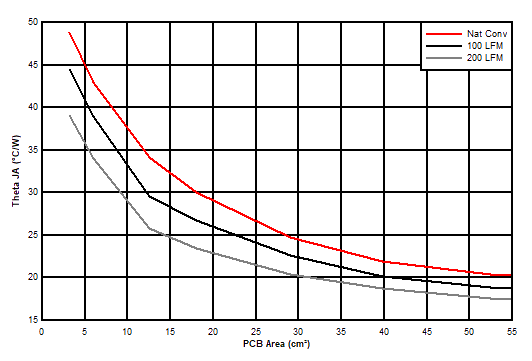SLVSFI4B December 2020 – October 2021 TPSM5601R5H , TPSM5601R5HE
PRODUCTION DATA
- 1 Features
- 2 Applications
- 3 Description
- 4 Revision History
- 5 Device Comparison Table
- 6 Pin Configuration and Functions
-
7 Specifications
- 7.1 Absolute Maximum Ratings
- 7.2 ESD Ratings
- 7.3 Recommended Operating Conditions
- 7.4 Thermal Information
- 7.5 Electrical Characteristics
- 7.6 Typical Characteristics (VIN = 12 V)
- 7.7 Typical Characteristics (VIN = 24 V)
- 7.8 Typical Characteristics (VIN = 48 V)
- 7.9 Typical Characteristics (VIN = 60 V)
- 8 Detailed Description
- 9 Applications and Implementation
- 10Power Supply Recommendations
- 11Layout
- 12Device and Documentation Support
- 13Mechanical, Packaging, and Orderable Information
Package Options
Mechanical Data (Package|Pins)
- RDA|15
Thermal pad, mechanical data (Package|Pins)
Orderable Information
11.2.1 Theta JA versus PCB Area
The amount of PCB copper as well as airflow effects the thermal performance of the device. Figure 11-5 shows the effects of copper area and airflow on the junction-to-ambient thermal resistance (RθJA) of the TPSM5601R5Hx. The junction-to-ambient thermal resistance versus PCB area is plotted for a 4-layer PCB.
To determine the required copper area for an application:
- Determine the maximum power dissipation of the device in the application by referencing the power dissipation graphs in the Typical Characteristics.
- Calculate the maximum θJA using Equation 3 and the maximum ambient temperature of the application.
Equation 3.

- Reference Figure 11-5 to determine the minimum required PCB area for the application conditions.
 Figure 11-5 θJA vs PCB
Area
Figure 11-5 θJA vs PCB
Area